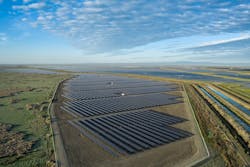Central California Solar Farm helps Stanford reach 100-percent Renewables goal
Stanford University’s motto, “as the wind of freedom blows” could be adapted to “as the sun of freedom shines” with commercial operation beginning on a new solar power farm that helps make the school virtually 100 percent renewable electricity driven.
The 63-MW Stanford Solar Generating Station 2 (SSGS2) began operations earlier this month in central California. SSGS2 is part of the larger solar and energy storage project called Slate, developed by Recurrent Energy and now owned by an offshoot of Goldman Sachs.
It is, the university says, the final component of the Stanford Energy System Innovations transition away from fossil-fueled power generation. This includes a 200-MW battery storage system and an earlier solar project.
Stanford completes the university’s transition to 100 percent renewable electricity. Stanford still has backup and on-site heat-recovery system, but the solar generation at capacity now exceeds what the university consumes, reaching a point of net-zero emissions.
“As we make our operations greener, we’re also committed to advancing global solutions through our mission of research and education,” school President Marc Tessier-Lavigne said in the university release. “Our new school focused on climate and sustainability, which opens its door this fall, will serve as a focal point for these efforts.”
Six years ago, Stanford converted from its combined heat and power project to grid-sourced electricity and a lower-emitting on-campus heat recovery system. That work, and its $485 million Central Energy facility, helped cut emissions at the time some 68 percent below earlier levels, according to reports.
Recurrent Energy, a wholly-owned subsidiary of Canadian Solar, remains project manager at the Slate-Stanford solar sites. Stanford is an offtaker, or buyer, along with Bay Area Rapid Transit, Silicon Valley Clean Energy, Central Coast Community Energy and the Power and Water Resources Pooling Authority.
Click here to read more about the Stanford Energy System Innovations program.
-- -- --
(Rod Walton, senior editor for EnergyTech, is a 14-year veteran of covering the energy industry both as a newspaper and trade journalist. He can be reached at [email protected]).
About the Author
Rod Walton, EnergyTech Managing Editor
Managing Editor
For EnergyTech editorial inquiries, please contact Managing Editor Rod Walton at [email protected].
Rod Walton has spent 17 years covering the energy industry as a newspaper and trade journalist. He formerly was energy writer and business editor at the Tulsa World. Later, he spent six years covering the electricity power sector for Pennwell and Clarion Events. He joined Endeavor and EnergyTech in November 2021.
Walton earned his Bachelors degree in journalism from the University of Oklahoma. His career stops include the Moore American, Bartlesville Examiner-Enterprise, Wagoner Tribune and Tulsa World.
EnergyTech is focused on the mission critical and large-scale energy users and their sustainability and resiliency goals. These include the commercial and industrial sectors, as well as the military, universities, data centers and microgrids. The C&I sectors together account for close to 30 percent of greenhouse gas emissions in the U.S.
He was named Managing Editor for Microgrid Knowledge and EnergyTech starting July 1, 2023
Many large-scale energy users such as Fortune 500 companies, and mission-critical users such as military bases, universities, healthcare facilities, public safety and data centers, shifting their energy priorities to reach net-zero carbon goals within the coming decades. These include plans for renewable energy power purchase agreements, but also on-site resiliency projects such as microgrids, combined heat and power, rooftop solar, energy storage, digitalization and building efficiency upgrades.

